The city of fish and Kitaro Sakaiminato Guide for Sightseeing
About Sakaiminato City
Location of Sakaiminato City


Sakaiminato City has been prospering with its natural port since early days.
Outline of Sakaiminato City
Sakaiminato City, located at the tip of Yumigahama Peninsula, is the city whose area is about 28 square kilometers. Since early days, Sakaiminato has grown with its fine natural port, to which the opposite Shimane Peninsula has been a protection against rough waves of Japan Sea and the monsoons. The city is complete with infrastructures such as harbor, airport and railroad. As a key trade point in the era of Japan Sea Rim and a Japan's major fishery base well known for its landing of large quantity of fish, Sakaiminato is on its way to become a city of international fishery and trade.
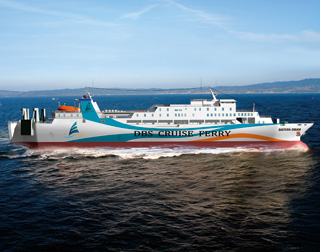
Eastern Dream, the international liner cargo-passenger ferry linking Japan, South Korea and Russia
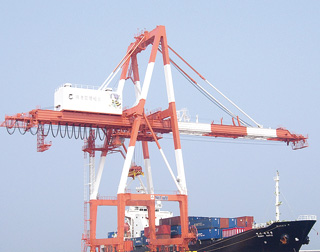
Total number of containers handled in 2014 was about 23,000TEU.
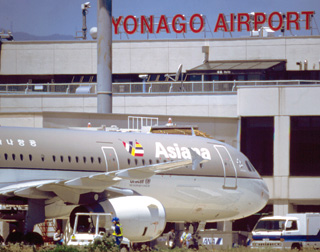
Flight to Seoul was put into service as one of the international flight schedules at the Yonago Kitaro Air Port.
Port of Sakai Flourishing With Overseas Trade
When looked at from countries on the opposite shores, Sakaiminato City is situated almost in the middle of West Japan. Sakaiminato has been, since early days, prosperous with overseas trade with the countries on the other side across the sea.
Sakaiminato was designated the port of foreign trade by the Japanese government in 1896, and it became a terminal of the railroad which was built in the San-in region for the first time in 1902 for the purpose of cargo transport. Regular shipping services opened during 1930's to Dalien, Inchon, Chongzin, Wonson, Busan and Pohan, and these services boosted the traffic of people and cargo.
In 1951, Sakaiminato was designated as one of the key national ports by the Japanese government in its recognition of the geographical advantage and past foreign trade showings. Projects for infrastructure including reclamation of the outer harbor area and building piers for large freight ships have been put into effect.
In 1995, the regular container services started to China and Korea. In 2004, the berth for 50,000-ton class ships started to use, along with a Gantry Crane which was installed for the first time of its kind in the San-in region, and provided the port more functions.
In 2009, DBS Cruise Ferry entered service, inaugurating an international liner cargo-passenger route linking the city with Donghae, South Korea, and Vladivostok, Russia. Sakaiminato is expected further advancement to be a gateway of Western Japan to Northeast Asia.

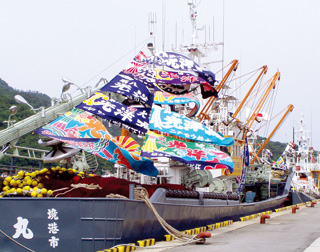
Saurel and macherel are major species of fishes which are caught and landed on by groups of circular net fishing boats.

Sakaiminato shares over 60% of all red snow crabs that land on Japan.
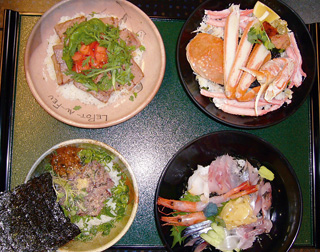
Sakaiminato's rice bowl topped with fresh fish and seafood
City with Top Class Fishery Base in Japan
Sakaiminato City is a fishery base bearing Sakai Fishing Port which was designated in 1973 as the Special Fish Port of Third Category. For 9 years since 1986, a landing of fish at Sakai Fishing Port has exceeded more than 500,000 tons each year. In 1993, Sakai Fishing Port reached its best of 690,000 tons of fish landing. 1992 through 1996, Sakai Fishing Port was No.1 in Japan for continuous five years, in terms of quantity of fish on landing. Sakai Fishing Port continues to be one of the major fishery bases in Japan.
Due to its abundant fish catches, Sakaiminato City bears many factories manufacturing fishery products, which accounts for more than 30% of its manufactured shipment value.
Sakai Fishing Port is No.1 in Japan for the quantity on combined landing of red snow crabs and snow crabs. Red snow crabs are processed to various food categories and are sold throughout Japan. Chitin and chitosan produced from the shells of red snow crabs are processed into dietary supplements and directed toward the use in medical and industrial field.
Bluefin tunas are landed during summer. Sakai Fishing Port is the country's largest landing port for raw bluefin tunas, and the tunas are distributed nationally. The tuna started to be used for the development of new food product. Tuna auction site is open for public. Tuna draws attention as a new resource for tourism.
In Sakaiminato City, visitors can enjoy a bowl of rice topped with fresh sashimi and sushi-go-round. There are 3 direct outlets in the city, where visitors can also purchase fresh fish and seafood at a reasonable price.

Sakaiminato City viewed through data
- Municipalization put into effect
- April 1, 1956
- Location
- Latitude 35 degrees 30 minutes North
Longtitude 133 degree 14 minutes East - Population
- 35,314 (Male 16,994 Female 18,320) as of Aug. 2015
- Area
- 29.02 square kilometers
- City Flower
- Chrysanthemum

- City Tree
- Black Pine Tree

- Muncipal Insignia

Designed with a letter out of the name of Sakaiminato, along with the image of port and wave.- Friendship Cities
- Hunchun City, Jilin Province, People’s Republic of China(October, 1993)
- Climate
- Temperatures are comparatively warm, but precipitation of rains is high throughout the year.
Transition of Temperatures at normal year

- Top page
- About Sakaiminato City
- Tourist Guide Map Of Sakaiminato City
- Mizuki Shigeru Road・Mizuki Shigeru Museum
- Yume Minato Tower
- History and culture have been closely connected with the sea.
- Festivals and Events
- Special Products
- Information For Access By Transportation
- Lodging
- Agencies and facilities
- Collection of Conversations
- Download brochure
- Links
Calling for Information
Commerce and Tourism Section, Industry Dept., Sakaiminato City
tsusyokanko@city.sakaiminato.lg.jp